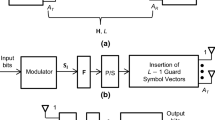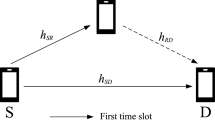Abstract
We consider the uplink of a multiuser cooperative dual-hop communication system, where users transmit signals towards a base station with the help of multiple relays. The base station is equipped with an antenna array, while each user and relay are single-antenna devices simultaneously accessing the channel using non-orthogonal codes. For this communication scenario, we propose a novel multiuser receiver for joint symbol and channel estimation by capitalizing on a tensor modeling of the end-to-end system. The proposed multiuser receiver allows the base station to jointly estimate users’ transmitted symbols and the channels involved in the dual-hop communication. Identifiability conditions of the proposed receiver are provided along with their practical implications to system design. Simulation results corroborate the effectiveness of our multiuser receiver in terms of channel estimation accuracy and bit-error-rate.






Similar content being viewed by others
Notes
These code sequences can be interpreted as columns of a space-time block code matrix. Since we are deadling with a joint (multiuser) detection approach at the receiver, the CDMA terminology is preferable.
The idea proposed in this work can easily be extended to include direct links.
The proposed model can easily be extended to multiple-antenna relays. It suffices to redefine \({\mathbf {H}}^{(\text {sr})}=[{\mathbf {H}}^{(\text {s})T}_1, \ldots , {\mathbf {H}}^{(\text {s})T}_R]^T \in {\mathbb {C}}^{{QR}\times {M}}\) as a block-matrix, where \(Q\) denotes the number of antennas at each relay (assumed to be equal for all relays without loss of generality).
The chip duration for both hops is the same, and there is a one-to-one correspondence between the chip indices of the MS–RS and RS–BS transmissions. As will be clear later, this transmission strategy is beneficial for the joint estimation of all channels as well as for the separation/detection of the multiple signals involved in the communication.
This means that each column of the estimated channel \({\mathbf {H}}^{(\text {rd})}\) is normalized by its first element, so that the first row of \({\mathbf {H}}^{(\text {rd})}\) is equal to the “all-ones” row vector. This is equivalent to normalize to unity the channel gains associated with the first receive BS antenna. Note, however, that this ambiguity is not an issue when optimizing the relay channel.
References
Sendonaris, A., Erkip, E., & Aazhang, B. (2003). User cooperation diversity—Part I: System description. IEEE Transactions on Communications, 51(11), 1927–1938.
Laneman, J. N., Tse, D. N. C., & Wornell, G. W. (2004). Cooperative diversity in wireless networks: Efficient protocols and outage behavior. IEEE Transactions on Information Theory, 50(12), 3062–3080.
Pabst, R., Walke, B., Schultz, D., Herhold, P., Yanikomeroglu, H., Mukherjee, S., et al. (2004). Relay-based deployment concepts for wireless and mobile broadband radio. IEEE Communications Magazine, 42(9), 80–89.
Cao, L., Zhang, J., & Kanno, N. (2009). Multi-source cooperative communications with relay-coding for uplink IMT-advanced 4G systems. In Proceedings on IEEE GLOBECOM’09 (pp. 1–6).
Liu, K., Sadek, A., Su, W., & Kwasinski, A. (2008). Cooperative communications and networking. Cambridge: Cambridge University Press.
Dohler, M., & Li, Y. (2010). Cooperative communications: Hardware, channel and PHY. London: Wiley.
Rong, Y. (2010). Optimal joint source and relay beamforming for MIMO relays with direct link. IEEE Communications Letters, 14(5), 390–392.
Roemer, F., & Haardt, M. (2010). Tensor-based channel estimation and iterative refinements for two-way relaying with multiple antennas and spatial reuse. IEEE Transactions on Signal Processing, 58(11), 5720–5735.
Fernandes, C. A. R., de Almeida, A. L. F., & Costa, D. B. (2012). Unified tensor modeling for blind receivers in multiuser uplink cooperative systems. IEEE Signal Processing Letters, 19(5), 247–250.
Rong, Y., Khandaker, M., & Xiang, Y. (2012). Channel estimation of dual-hop MIMO relay system via parallel factor analysis. IEEE Transactions on Wireless Communications, 11(6), 2224–2233.
Harshman, R.A. (1970). Foundations of the PARAFAC procedure: Models and conditions for an “explanatory” multimodal factor analysis, 16th ed. UCLA Working Papers in Phonetics.
Bro, R. (1998). Multi-way analysis in the food industry: Models, algorithms and aplications, Ph.D. dissertation. Amsterdam: University of Amsterdam.
Smilde, A., Bro, R., & Geladi, P. (2004). Multi-way analysis. London: Wiley.
Sidiropoulos, N. D., Giannakis, G. B., & Bro, R. (2000). Blind PARAFAC receivers for DS-CDMA systems. IEEE Transactions on Signal Processing, 48(3), 810–823.
Gregoratti, D., & Mestre, X. (2009). Random DS/CDMA for the amplify and forward relay channel. IEEE Transactions on Wireless Communications, 8(2), 1017–1027.
Harshman, R. A., & Lundy, M. E. (1996). Uniqueness proof for a family of models sharing features of Tucker’s three-mode factor analysis and PARAFAC/CANDECOMP. Psychometrika, 61(1), 133–154.
Kibangou, A.Y., & Favier, G. (2007). Blind joint identification and equalization of Wiener-Hammerstein communication channels using PARATUCK tensor decomposition. In Proceedings EUSIPCO’07, Poznan, Poland.
de Almeida, A. L. F., Favier, G., & Mota, J. C. M. (2009). Space-time spreading-multiplexing for MIMO wireless communication systems using the PARATUCK tensor model. Signal Processing, 89, 2103–2116.
da Costa, M. N., Favier, G., de Almeida, A. L. F., & Romano, J. M. T. (2012). Tensor space-time (TST) coding for mimo wireless communication systems. IEEE Transactions on Signal Processing, 92(4), 1079–1092.
Almeida, A. L. F., Favier, G., & Ximenes, L. R. (2013). Space-time-frequency (STF) MIMO communication systems with blind receiver based on a generalized PARATUCK model. IEEE Transactions on Signal Processing, 61(8), 1895–1909.
Lioliou, P., Viberg, M., & Coldrey, M. (2012). Efficient channel estimation techniques for amplify and forward relaying systems. IEEE Transactions on Communications, 60(11), 3150–3155.
Kong, T., & Hua, Y. (2011). Optimal design of source and relay pilots for MIMO relay channel estimation. IEEE Transactions on Signal Processing, 59(9), 4438–4446.
Acknowledgments
This work was supported by the China’s Next Generation Internet Project (CNGI Project) “Research and Trial on Evolving Next Generation Network Intelligence Capability Enhancement (NICE)”, Beijing Higher Education Young Elite Teacher Project and DNSLAB. The research of André L. F. de Almeida is partially supported by CNPq/Brazil.
Author information
Authors and Affiliations
Corresponding author
Rights and permissions
About this article
Cite this article
Xi, H., de Almeida, A.L.F. Multiuser Receiver for Joint Symbol/Channel Estimation in Dual-Hop Relaying Systems. Wireless Pers Commun 83, 17–33 (2015). https://doi.org/10.1007/s11277-015-2377-3
Published:
Issue Date:
DOI: https://doi.org/10.1007/s11277-015-2377-3




